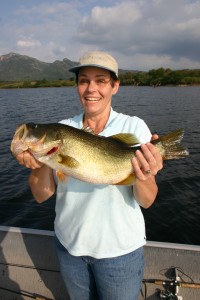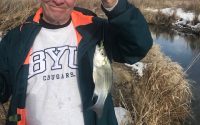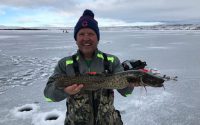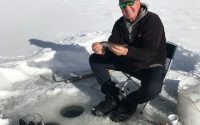Too Much Water — Too Few Fish

The relationship between numbers of available fish to catch and the amount of water in lakes and streams is directly proportionate. I know that statement is tough for fish and game officials to swallow, especially in the drought-ridden states in the western U.S, but facts are facts, more water equals fewer fish. Allow me to explain.
When water comes up in reservoirs particularly, it creates more surface acres in which the fish can reside. Much of bass habitat is shallow with a lot of cover, downed trees, grass, flooded standing trees, etc. During very wet water years, the acceptable bass habitat is increased many times it normal size. There are generally no more bass (meaning no new bass) and so by applying a little logic to the equation there will be more water and fewer concentrations of bass or fewer “catch-able” bass.
Throughout this spring and on into summer, the lakes in Utah, parts of Colorado, Idaho, Nevada, and other states have reported slower than usual catch rates even though fish and game departments keep saying 2011 will provide some of the best fishing in the past decade.
Let’s take a look at how to make the most of fishing in high-water conditions. First, always remember that bass are bass are bass. Smallmouths are able to adjust to rising water just a little bit easier than largemouth bass. That doesn’t mean that both species don’t react well to rising water but smallmouth bass tend to like deeper areas and therefore, when water rises they can very quickly drop a few feet on vertical structure and basically remain in the same location. Even while nesting, whether a smallmouth bed is in four feet or 10 feet of water it is most likely still viable. The same is true for largemouth bass however, largemouth bass are quick to move shallower when the water begins to rise. It is not uncommon to find largemouth bass feeding and resting in water just deep enough to cover their backs.
To figure out both species and to pinpoint areas in which they may congregate, don’t move too far away from channel breaks and points. Bass feed and feed often throughout the summer after the effects of the spawn wear off. Recognize that at first, the bass will stay very close to where they were before the water began to rise. So, a weedbed that was in five feet of water before the rise, will still have bass living near it even though the water might be 15 feet deep or even more. Here are a few ideas for targeting these fish.
Stay close to your fish finder and look for active fish. I have an e-book coming out about understanding fish finders which would tell you to be aware of the species in the lake you are fishing and learn to identify each of the marks on your screen. It might sound tough but it really isn’t. One of lake I frequent has carp, smallmouth bass, catfish, trout, lake trout, suckers, and burbot. If you understand where each of those species likes to live, you can eliminate marks on your finder with little difficulty. Catfish like to be on the bottom, so do suckers, but bass prefer to be a foot or so off the bottom although they are free to go wherever they choose. Carp are generally a larger mark and trout like to suspend in the water column much more than roaming around against the bottom. So, look for bass around the points or on the edges of channels in the lower part of the water column. Then, when you catch one, you can duplicate the event all over the lake.
The best search baits for high water deeper bass are soft plastics. I prefer using a drop-shot rig and a 4-inch worm in green pumpkin or even black. Use a leader around 2-feet long and drop directly on top of the marks on your screen.
For shallow bass, my single best tip is to look in the same areas, channel breaks and points and then follow them to the nearest shallow flat. Many times that will be a spawning flat, and you may even find fry near the area. Where there are fry, there are also larger bass. Probe these areas with a lipless crankbait in minnow colors.
Now that you’ve found a few fish, determine what they are eating. At some point in the summer Utah bass change gears and move from eating crawfish to eating minnows. Now, don’t think they exclusively eat one thing or another but there is no question at certain times they like one forage over another. Test the theory out by throwing a crawdad crankbait in shallow water and see if any fish react to the bait. Next, try a crankbait that looks like a minnow. From there you should be able to determine whether the bite will be aggressive or passive. If it is an aggressive bite, the fish will react to spinnerbaits, crankbaits, swimbaits or flukes. If the bite is passive they will respond to soft plastics such as worms, grubs, or Carolina rigged creature baits.
This is just an overview at best. Just be patient and in time, the fishing will improve as the fish settle into their new homes in a much larger pool of water. Then, as the weather cools towards fall, they will go back to their old habits of chasing prey and eating to prepare for winter. Then, the world will be put right again and we can get back to catching instead of just fishing.










